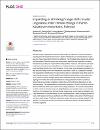Expanding or shrinking? range shifts in wild ungulates under climate change in Pamir-Karakoram mountains, Pakistan
| Author | Ali, Hussain |
| Author | Din, Jaffar Ud |
| Author | Bosso, Luciano |
| Author | Hameed, Shoaib |
| Author | Kabir, Muhammad |
| Author | Younas, Muhammad |
| Author | Nawaz, Muhammad Ali |
| Available date | 2022-03-23T06:52:13Z |
| Publication Date | 2021-12-01 |
| Publication Name | PLoS ONE |
| Identifier | http://dx.doi.org/10.1371/journal.pone.0260031 |
| Citation | : Ali H, Din JU, Bosso L, Hameed S, Kabir M, Younas M, et al. (2021) Expanding or shrinking? range shifts in wild ungulates under climate change in Pamir-Karakoram mountains, Pakistan. PLoS ONE 16(12): e0260031. https://doi. org/10.1371/journal.pone.0260031 |
| Abstract | Climate change is expected to impact a large number of organisms in many ecosystems, including several threatened mammals. A better understanding of climate impacts on species can make conservation efforts more effective. The Himalayan ibex (Capra ibex sibirica) and blue sheep (Pseudois nayaur) are economically important wild ungulates in northern Pakistan because they are sought-after hunting trophies. However, both species are threatened due to several human-induced factors, and these factors are expected to aggravate under changing climate in the High Himalayas. In this study, we investigated populations of ibex and blue sheep in the Pamir-Karakoram mountains in order to (i) update and validate their geographical distributions through empirical data; (ii) understand range shifts under climate change scenarios; and (iii) predict future habitats to aid long-term conservation planning. Presence records of target species were collected through camera trapping and sightings in the field. We constructed Maximum Entropy (MaxEnt) model on presence record and six key climatic variables to predict the current and future distributions of ibex and blue sheep. Two representative concentration pathways (4.5 and 8.5) and two-time projections (2050 and 2070) were used for future range predictions. Our results indicated that ca. 37% and 9% of the total study area (Gilgit-Baltistan) was suitable under current climatic conditions for Himalayan ibex and blue sheep, respectively. Annual mean precipitation was a key determinant of suitable habitat for both ungulate species. Under changing climate scenarios, both species will lose a significant part of their habitats, particularly in the Himalayan and Hindu Kush ranges. The Pamir-Karakoram ranges will serve as climate refugia for both species. This area shall remain focus of future conservation efforts to protect Pakistan’s mountain ungulates. |
| Language | en |
| Publisher | Public Library of Science |
| Subject | Karakoram Mammal Climate Change |
| Type | Article |
| Issue Number | 12 |
| Volume Number | 16 |
Files in this item
This item appears in the following Collection(s)
-
Biological & Environmental Sciences [934 items ]


